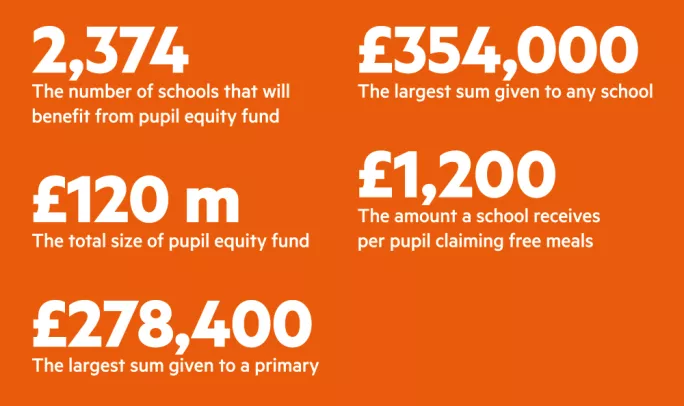Evidence-based approach to pupil equity ‘lacks evidence’

Academics have hit out at the “disappointing” quality of government guidance on how schools should spend the £120 million they are being given to support disadvantaged pupils.
The warning comes as schools are set to receive an additional £1,200 for every pupil claiming for a free school meal, under the Pupil Equity Fund being introduced in April.
Last month, a website was launched in order to guide headteachers’ spending decisions and education secretary John Swinney said it was “imperative” that Scotland took an “evidence-based approach to driving improvement”. Teachers and school leaders now had “access to effective interventions based on practice examples from around Scotland”, he said.
However, the site - hosted by Education Scotland and called Interventions for Equity - has been heavily criticised by education research experts for the lack of evidence underpinning the projects it highlights.
Sue Ellis, professor of education at the University of Strathclyde, said: “This is an interesting list of the current projects in Scotland, but we need to be clear about what the evidence base is that makes this more than just a list of nice ideas.”
A literacy project being led by Professor Ellis was one such initiative listed on the site, but the research is not due to bear its first set of strong data until July, she said.
She warned: “This failure to provide good advice could lead to taxpayers’ money being wasted; teachers putting effort and work into things that turn out to be snake oil, and becoming demoralised and cynical about change; and our most vulnerable children not being given the help they need.”
Thousands of schools benefit
The Scottish government announced last week that 2,374 schools would benefit from the fund.
Some schools will see their budgets increase 18-fold, such as Dalmarnock Primary in Glasgow, where funding will increase from about £15,000 devolved to the school per year to £278,400.
Gerry Lyons, headteacher of St Andrew’s Secondary in Glasgow, received the biggest slice of the pupil equity fund, at £354,000. He said: “We want to be going forward with activity and approaches that the evidence base says works. To me, that’s crucial.”
There is certainly no evidence whatsoever here of the ‘international research’ that was supposed to buttress these recommendations
But Professor Ellis is not alone in worrying that teachers will have insufficient evidence upon which to base their spending decisions. Laura Colucci-Gray, past president of the Scottish Educational Research Association, told TESS that the evidence to support the featured projects was “very limited and largely invisible”.
She warned against putting pressure on schools and teachers to deliver results through the interventions listed, without having proof that they actually worked.
Dr Colucci-Gray, who is based at the University of Aberdeen, said: “The resources presented here are inspiring experiences which speak directly to teachers and may stimulate professional engagement. However, it is misleading to think of such selected examples as ‘evidence’.”
She added: “While the rationale of the activities is provided and, in the main, all activities are tackling some form of disadvantage, it is hard to discriminate between what is a ‘good idea or practice’ and the impact that this effectively has on pupils.”
‘Poor quality’ evidence
Keith Topping, professor emeritus of education at the University of Dundee, said: “This material is very disappointing. Firstly, the claim is that the interventions mentioned are ‘evidence based’. Yet there is often no evidence within the details nor any reference to any evidence outside. A few interventions have some evidence, which is generally of very poor quality.”
Like Professor Ellis, Professor Topping had a piece of work listed - the Primary One Literacy Assessment and Action Resource - but he said that the website failed to make clear the evidence supporting it.
He also criticised the website for failing to look beyond Scotland.
Professor Topping continued: “There is certainly no evidence whatsoever here of the ‘international research’ that was supposed to buttress these recommendations.”

Education Scotland told TESS that the site was a work in progress and that, later this month, a Scottish version of the Education Endowment Foundation’s (EEF) teaching and learning toolkit would be made available to schools.
The EEF has been helping English schools decide how to spend their pupil premium - the equivalent of the pupil equity fund - since 2011.
A spokesperson for Education Scotland said: “Interventions for Equity is based on a range of approaches currently being used to good effect in Scottish schools. At this stage, it provides a stimulus for discussions around improvement planning, and it will be developed further in the coming weeks and months. It extends the knowledge and research resources already available on the National Improvement Hub.”
You need a Tes subscription to read this article
Subscribe now to read this article and get other subscriber-only content:
- Unlimited access to all Tes magazine content
- Exclusive subscriber-only stories
- Award-winning email newsletters
Already a subscriber? Log in
You need a subscription to read this article
Subscribe now to read this article and get other subscriber-only content, including:
- Unlimited access to all Tes magazine content
- Exclusive subscriber-only stories
- Award-winning email newsletters